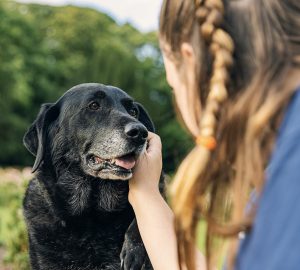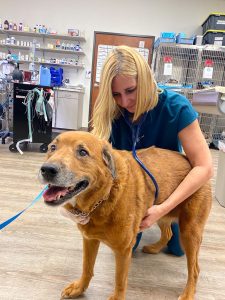Everything Pet Parents Should Know About Canine and Feline Cancer and a Promising New Diagnostic Tool
Cancer is something that no one wants to hear and is, unfortunately, significantly more common than most pet owners think. However, there is an indirect bright side to this situation—our pets are living much longer. This results from proper health screening regularly, efficient immunization protocols, well-balanced diets, and advanced diagnostics that help us catch diseases earlier. Not only that, but we spend so much time with our pets in this day and age. Most dogs and cats live indoors with us now, which means, as pet owners, we’re much more aware of what is going on with them.
All of that is well and good, but it also serves to frustrate us as pet parents and pet health care providers, as we can do everything right, yet cancer can still affect our beloved companions. Just as with humans, that is perhaps the most frustrating thing about cancer—so many kinds and types of cancers can affect all body parts. There’s no real way for us to prevent cancer in pets, but knowledge about how to spot and treat it is always beneficial.
Cancer Terms to Understand as a Pet Parent
Before discussing “cancer,” we need to use the same terms. A few words commonly associated with cancer are tumor, malignant, and benign. These terms are often used interchangeably, but that is incorrect.
Some cancer terms to know and understand are:
Tumor — This refers to a proliferation of tissue, resulting in a mass.
Malignant — Tumors can be malignant or benign. Malignant tumors do spread, meaning they can spread to other parts of the body.
Benign — The most straightforward way to explain the difference is that benign tumors do not spread; this does not mean they aren’t dangerous, however.

Generally speaking, if a benign tumor is found and removed, the problem is gone. However, with a malignant tumor, just because you remove the mass does not mean the issue is resolved. It may have already spread elsewhere in the body, and thus, simple removal may not be curative.
The term cancer in and of itself is something we should understand. It refers to a mutation of cells causing an abnormally rapid division/growth of those cells. The term cancer is synonymous w/ malignancy. For example, “cancerous mass” and “malignant mass” mean the same thing. You can undoubtedly have cancerous mass, but cancer doesn’t have to be a mass; you can have cancer of certain blood cells, the most common being leukemia, which is cancer of the white blood cells.
What does it look like if my pet has cancer?
Now that we’ve established some basic terms surrounding cancer, we can discuss cancer more in-depth in our pets. As for what cancer in pets looks like, it can look like anything. Cancer symptoms are dictated by where the cancer is and what part of the body it affects.
For example, some types of pet cancer and their accompanying symptoms are:
- If there is cancer of the intestinal lymph nodes, it could present as gastrointestinal-associated symptoms, like vomiting, diarrhea, or a lack of appetite.
- If there is cancer in the lungs, it could present as coughing or breathing problems, or it could be a skin mass that is grossly visible.
- In the case of leukemia in cats (FeLV, Feline Leukemia Virus), it may be discovered on a routine blood panel. Your pet could be completely asymptomatic, and thus your pet appears completely healthy.
What causes cancer in dogs and cats?
This is a difficult question to answer as it is typically phrased, essentially saying that “cancer” is a single disease. We know there are many types of cancers in people and our pets. That said, there have been some types of cancers for which we’ve been able to directly link a cause. For example, a kitten we find to have the virus that causes Feline Leukemia will become symptomatic for leukemia at some point in their life; we just don’t know when. Some types of cancers are hereditary, like hemangiosarcoma (cancer of the spleen) or osteosarcoma (bone cancer). Other types of cancers are sexually transmitted, such as transmissible venereal tumors (TVT).
Still, there are many other types of cancers that we, unfortunately, don’t know why pets get them. However, we do know that all of them involve a mutation of the gene, or DNA, of the cells it affects. This mutation, which may be an addition or deletion of a certain part of the DNA, results in a very rapid proliferation of abnormal cells.

Is my pet at risk for cancer?
The short answer is yes, as no pet is immune to cancer. Sadly, cancer can affect any pet at any age. There are some general guidelines we can follow, however, as there are undoubtedly different demographics of pets that are at a higher risk of cancers.
Risk factors for pet cancer are as follows:
Age — The older an animal is, the higher the chance cancer may cause their illness.
Gender — Prostate cancer can affect intact males, and mammary cell carcinoma can affect intact females. Spaying or neutering will dramatically decrease, if not eliminate, that risk in our pets.
Breed — Some breeds are more prone to certain cancers. Labrador and Golden Retrievers suffer from splenic tumors (hemangiosarcoma or hemangioma) more often than other breeds. Large and giant breed dogs—Rottweilers and German Shepherds, among others—seem to be over-represented in the category of osteosarcoma. Beagles and cats seem to contract lymphoma more often than other breeds. And Pit Bulls and Boxers seem dramatically more affected by malignant dermal masses like mast cell tumors (MCT) and/or melanoma.
The critical point is that these are not absolutes. For instance, Beagles can get other forms of cancer, and just because you have a Beagle does not mean your pet will get lymphoma. It’s simply a consideration that veterinarians take into account if your pet were to come into the clinic with some non-specific signs of illness.
How can I test my pet for cancer?
There are multiple ways we can screen for cancer in our pets. This goes back to our original assertion that what cancer looks like is determined by what part of the body it affects. Many times, routine lab work is the first step. However, routine blood work will rarely reveal true cancer. Instead, it will give us some distinctive clues, especially when combined with the physical exam findings, history, age, and breed of the pet. These clues often direct us to more specific testing such as abdominal ultrasound, CT scan, or even more specific blood tests like BRAF testing, a blood test for bladder cancer.

This brings us to a very exciting, relatively recent development in veterinary medicine. One of the most common questions we receive that I’ve already alluded to is, “Does the blood work say my pet has cancer?” Since the beginning of veterinary medicine and the use of diagnostics, 99% of the time, that answer would be no; we aren’t able to say for sure—that is until now! A fascinating recent advancement is the development of blood tests that actually tell you if your pet has cancer or not—specifically OncoK9 and NuQ.
Unfortunately, these tests are not commercially available for cats yet. Still, this is a fascinating development in veterinary medicine and has the potential to be very useful, particularly OncoK9. As it is currently developed and can be used, it often leaves us, as pet owners and veterinarians, with more questions. We have established there are many different types of cancers, and this test reports the result as a clear “yes” or “no” as to whether there is cancer present. The good news is that the result is quite reliable. The bad news is, except for 2-4 specific cancer types, it doesn’t tell you what kind of cancer your pet has. So, at that point, we would need to go on a hunt trying to find out where the cancer is, which can get expensive as we start looking at X-rays of the chest and abdomen, ultrasound, CT, and possibly even MRI and/or specific blood testing.
This test will get developed more, and it currently holds potential. It is quite exciting right now to answer that all-concerning question of “Does my pet have cancer?” But as it is right now, just answering that question does not leave us with information we can use to take actionable steps.
Is this mass cancer?
Growths, masses, lesions, etc., are common in dogs but less so in cats. The overwhelming majority are not cancer, but we don’t know based on appearance. We can make some admittedly gross observations to let us know if the mass is worrisome.
There are five different aspects we can use to evaluate a mass or growth of a pet to guide us on how to proceed:
- Is the pet bothered by the mass? Are they biting, scratching, or otherwise irritated by the mass? If they are, then we should strongly consider removing them.
- Have you (the pet owner) noticed it is growing? Was it just noted 1-2 weeks ago, or has it doubled in size within a month or two? If it has, we need to either investigate further or remove it. If it has been present for the past 5+ years and is unchanged in that time, we don’t need to ignore it, per se, but we don’t need to be as worried about it.
- Is the mass inflamed or bleeding? If a mass is inflamed or bleeding, that typically means the pet is bothered by it, so that’s already an answer to question 1. But even a benign mass (i.e., not cancer) can be inflamed; if it is, that can leave the area open to infection.
- Is the mass attached or moveable? One of the first things veterinarians do when evaluating a new mass on a pet is to palpate it. We’ll feel if we can lift it from the underlying tissue—meaning is it just in the skin, or is it attached to the muscle or bone? This is important because if it is attached, that is typically much more concerning. Furthermore, although just because it is attached doesn’t mean it can’t be removed, it will be much more complex than a growth on the skin or in the subcutaneous tissue.
- Where is it located on the body? This question is crucial because it relates to how easily it can be removed. For instance, a golf-ball-sized mass on top of the shoulder can easily be removed in most circumstances, as the skin there is not under much tension. Therefore, when we remove the mass and a gap is left, as a surgeon, we must ensure we can close it. On the shoulder, that would be no problem. However, even a tiny, marble-sized mass on the top of the paw is a big issue. The tissue there is under much tension, and it would be extremely difficult to close the gap left after removing the mass. In other words, masses on the extremities (i.e., legs, tail) are typically looked at a little differently than those on the trunk or body of our patients.
If any of the above questions worry us about a mass, it’s time to decide on an action. Typically, from here, we would proceed with what’s referred to as an FNA, or Fine Needle Aspirate. This involves sticking a needle in the mass, and rather than injecting anything; we use a syringe to suck cells out. We then “spray” that material on a microscope slide to see if any cells indicate a cancerous mass. This is not the same as a biopsy. A biopsy involves cutting a section of the mass out and looking at that section under a microscope. A true biopsy is much more helpful than an FNA, but a biopsy is also much more involved. Obtaining an FNA sample is like giving a vaccine—simple, not painful, and inexpensive. On the other hand, a biopsy will typically involve sedation or at least a local anesthetic, a minor surgery to “cut” out a section of the tissue, and then, of course, some stitches to close the area.
Is cancer in pets treatable?
Many times, yes, but not always. There are too many variables to answer this common question as it is asked. Once again, it depends on the type of cancer.
Other variables we must consider when answering whether cancer in pets is treatable are:
- How advanced is the disease process?
- How risky is the therapy?
- What is the risk/benefit analysis—for example, is it a very risky procedure, and the best-case scenario would be an additional 1-2 months?
- Are there any other comorbidities (other conditions)? For example, is there already some advanced form of heart or kidney disease?
- How expensive is the treatment?
It would be best to discuss all these considerations with your veterinarian and not make any assumptions. You would be surprised at what conditions are quite treatable now.
A final point regarding the considerations above is that these answers are different for each family. For example, an additional six months may be life-changing for one family, whereas for another, they don’t wish to see their beloved pet decline any further. Or perhaps a family has pet insurance, and thus the cost of the treatment is not a substantial concern. In contrast, another family does not have pet insurance, and taking on a potential $2000-4000 investment in a risky surgery may not be feasible. It is an unfortunate yet realistic consideration that we, as pet owners and veterinarians, must often face.
I’ve seen what chemotherapy and radiation therapy do to people with cancer—what if I don’t want my pet to go through that?
This is a great question and a widespread consideration and assumption many clients make when a referral to an oncologist is mentioned. There’s no getting around the fact that cancer therapy, in the simplest terms, involves poisoning the body. Whether it is radiation therapy or chemotherapy, we essentially poison the body with a radioactive substance. Ideally, this substance will target only the cancerous cells, but unfortunately, it does not. We have substantial research and specific protocols for different cancers, allowing us to be much more directed at certain cancers. Still, you will inevitably get some damage to other normal, otherwise healthy cells. That is where the effects that we often see in people come from.

In human oncology, those effects are taken to the brink, especially with aggressive forms of cancer, and the side effects can be quite dramatic. This is where things differ quite a bit in veterinary oncology. Veterinary oncologists and your primary care veterinarian will consider their quality of life during and after treatment. If the side-effects of the therapy will leave your pet too immunocompromised and at risk for other “normal” diseases, will require your pet to take multiple medications for the rest of their life, or leave them so depleted of energy that they just lay down all day, we might decide that’s not a quality of life. This is a critical discussion to have with your veterinarian and will be very different for each pet and family.
Cancer is a horrible disease; unfortunately, because our pets are living so much longer than they have in decades before, it is becoming more common. Add to that our ability to diagnose it; given the advancements we have in our testing; we can discover cancer more often and earlier than we have ever been able to before. The word cancer is commonly used and often associated with hopelessness. It is obviously not ideal, but it is also not hopeless. There will be difficult discussions that will need to happen with your veterinarian and within your family. It is no longer the automatic death sentence it once was. Our ability to obtain an accurate diagnosis and, thus, prognosis and potential treatment may be much more available than you initially may think.
If you have more questions about dog or cat cancer or if your precious pet has recently been diagnosed, please don’t hesitate to contact us to discuss your options.
